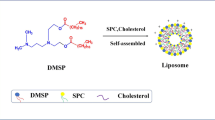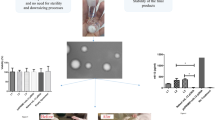No Heading
Purpose.
A fully scalable and extrusion-free method was developed to prepare rapidly and reproducibly stabilized plasmid lipid particles (SPLP) for nonviral, systemic gene therapy.
Methods.
Liposomes encapsulating plasmid DNA were formed instantaneously by mixing lipids dissolved in ethanol with an aqueous solution of DNA in a controlled, stepwise manner. Combining DNA-buffer and lipid-ethanol flow streams in a T-shaped mixing chamber resulted in instantaneous dilution of ethanol below the concentration required to support lipid solubility. The resulting DNA-containing liposomes were further stabilized by a second stepwise dilution.
Results.
Using this method, monodisperse vesicles were prepared with particle sizes less than 200 nm and DNA encapsulation efficiencies greater than 80%. In mice possessing Neuro 2a tumors, SPLP demonstrated a 13 h circulation half-life in vivo, good tumor accumulation and gene expression profiles similar to SPLP previously prepared by detergent dialysis. Cryo transmission electron microscopy analysis showed that SPLP prepared by stepwise ethanol dilution were a mixed population of unilamellar, bilamellar, and oligolamellar vesicles. Vesicles of similar lipid composition, prepared without DNA, were also <200 nm but were predominantly bilamellar with unusual elongate d morphologies, suggesting that the plasmid particle affects the morphology of the encapsulating liposome. A similar approach was used to prepare neutral egg phosphatidylcholine:cholesterol (EPC:Chol) liposomes possessing a pH gradient, which was confirmed by the uptake of the lipophilic cation safranin O.
Conclusions.
This new method will enable the scale-up and manufacture of SPLP required for preclinical and clinical studies. Additionally, this method now allows for the acceleration of SPLP formulation development, enabling the rapid development and evaluation of novel carrier systems.
Similar content being viewed by others
Abbreviations
- Chol:
-
cholesterol
- DODAC:
-
dioleyldimethylammonium chloride
- DODAP:
-
1,2-dioleoyl-N,N-dimethyl-3-aminopropane
- DODMA:
-
1,2-dioleyloxy-N,N-dimethylaminopropane
- DOPE:
-
dioleoylphosphatidylethanolamine
- DOPG:
-
dioleoylphosphatidylglycerol
- DSPC:
-
distearoylphosphatidylcholine
- EPC:
-
egg phosphatidylcholine
- HBS:
-
Hepes buffered saline
- 3H-CHE:
-
tritium-labeled cholesteryl hexadecyl ether
- OGP:
-
octylglucopyranoside
- PBS:
-
phosphate buffered saline
- PEG-CerC20:
-
1-O-(2′-(ω-methoxypolyethyleneglycol)2000)-2-N-arachidoylsphingosine
- PEG-S-DSG:
-
3-O-(2′(ω-methoxypolyethyleneglycol)2000)-1,2-distearoyl-sn-glycerol
- QELS:
-
quasi-elastic light scattering
- SPLP:
-
stabilized plasmid lipid particles
- SVF:
-
spontaneous vesicle formation
- TE:
-
Tris EDTA buffer
- TEM:
-
transmission electron microscopy
- TNS:
-
potassium 2-(p-toluidino)-6-naphthalenesulfonic acid
References
1. MacLachlan, P. Cullis, and R. W. Graham. Progress towards a synthetic virus for systemic gene therapy. Curr. Opin. Mol. Ther. 1:252–259 (1999).
2. A. Gabizon, H. Shmeeda, and Y. Barenholz. Pharmacokinetics of pegylated liposomal doxorubicin: review of animal and human studies. Clin. Pharmacokinet. 42:419–436 (2003).
3. A. H. Sarris, F. Hagemeister, J. Romaguera, M. A. Rodriguez, P. McLaughlin, A. M. Tsimberidou, L. J. Medeiros, B. Samuels, O. Pate, M. Oholendt, H. Kantarjian, C. Burge, and F. Cabanillas. Liposomal vincristine in relapsed non-Hodgkin’s lymphomas: early results of an ongoing phase II trial. Ann. Oncol. 11:69–72 (2000).
4. L. D. Mayer, R. Nayar, R. L. Thies, N. L. Boman, P. R. Cullis, and M. B. Bally. Identification of vesicle properties that enhance the antitumour activity of liposomal vincristine against murine L1210 leukemia. Cancer Chemother. Pharmacol. 33:17–24 (1993).
5. N. L. Boman, M. B. Bally, P. R. Cullis, L. D. Mayer, and M. S. Webb. Encapsulation of vincristine in liposomes reduces its toxicity and improves its anti-tumor efficacy. J. Liposome Res. 5:523–541 (1995).
6. M. S. Webb, T. O. Harasym, D. Masin, M. B. Bally, and L. D. Mayer. Sphingomyelin-cholesterol liposomes significantly enhance the pharmacokinetic and therapeutic properties of vincristine in murine and human tumour models. Br. J. Cancer 72:896–904 (1995).
7. J. J. Wheeler, L. Palmer, M. Ossanlou, I. MacLachlan, R. W. Graham, Y. P. Zhang, M. J. Hope, P. Scherrer, and P. R. Cullis. Stabilized plasmid-lipid particles: construction and characterization. Gene Ther. 6:271–281 (1999).
8. P. Tam, M. Monck, D. Lee, O. Ludkovski, E. Leng, K. Clow, H. Stark, P. Scherrer, R. W. Graham, and P. R. Cullis. Stabilized plasmid lipid particles for systemic gene therapy. Gene Ther. 7:1867–1874 (2000).
9. N. Maurer, K. F. Wong, H. Stark, L. Louie, D. McIntosh, T. Wong, P. Scherrer, S. C. Semple, and P. R. Cullis. Spontaneous entrapment of polynucleotides upon electrostatic interaction with ethanol-destabilized cationic liposomes. Biophys. J. 80:2310–2326 (2001).
10. D. B. Fenske, I. MacLachlan, and P. R. Cullis. Stabilized plasmid-lipid particles: a systemic gene therapy vector. Methods Enzymol. 346:36–71 (2002).
11. I. M. Hafez, S. Ansell, and P. R. Cullis. Tunable pH-sensitive liposomes composed of mixtures of cationic and anionic lipids. Biophys. J. 79:1438–1446 (2000).
12. M. A. Monck, A. Mori, D. Lee, P. Tam, J. J. Wheeler, P. R. Cullis, and P. Scherrer. Stabilized plasmid-lipid particles: pharmacokinetics and plasmid delivery to distal tumors following intravenous injection. J. Drug Target. 7:439–452 (2000).
13. P. L. Felgner, T. R. Gadek, M. Holm, R. Roman, H. W. Chan, M. Wenz, J. P. Northrop, G. M. Ringold, and M. Danielsen. Lipofection—a highly efficient, lipid-mediated DNA-transfection procedure. Proc. Natl. Acad. Sci. U. S. A. 84:7413–7417 (1987).
14. H. C. Birnboim and J. Doly. A rapid alkaline extraction procedure for screening recombinant plasmid DNA. Nucleic Acids Res. 7:1513–1523 (1979).
15. J. Sambrook, E. F. Fritsch, and T. Maniatis. In N. Ford, C. Nolan, and M. Ferguson (eds.), Molecular Cloning, Cold Spring Harbor Laboratory Press, New York, 1989, pp. 1.38–31.39.
16. S. Hirota, C. T. de Ilarduya, L. G. Barron, and F. C. J. Szoka. Simple mixing device to reproducibly prepare cationic lipid-DNA complexes (lipoplexes). Biotechniques 27:286–290 (1999).
17. C. H. Fiske and Y. Subbarow. The colorimetric determination of phosphorus. J. Biol. Chem. 66:375–400 (1925).
18. E. G. Bligh and W. J. Dyer. A rapid method of total lipid extraction and purification. Can. J. Biochem. Physiol. 37:911–917 (1959).
19. A. L. Bailey and P. R. Cullis. Modulation of membrane fusion by asymmetric transbilayer distributions of amino lipids. Biochemistry 33:12573–12580 (1994).
20. R. Thomas. The denaturation of DNA. Gene. 135:77–79 (1993).
21. T. Schlick, B. Li, and W. K. Olson. The influence of salt on the structure and energetics of supercoiled DNA. Biophys. J. 67:2146–2166 (1994).
22. L. D. Mayer, M. J. Hope, and P. R. Cullis. Vesicles of variable sizes produced by a rapid extrusion procedure. Biochim. Biophys. Acta 858:161–168 (1986).
23. B. L. Mui, P. R. Cullis, E. A. Evans, and T. D. Madden. Osmotic properties of large unilamellar vesicles prepared by extrusion. Biophys. J. 64:443–453 (1993).
24. M. Almgren, K. Edwards, and G. Karlsson. Cryo transmission electron microscopy of liposomes and related structures. Colloids and Surfaces A: Physiochemical and Engineering Aspects 174:3–21 (2000).
25. B. L. Mui, H. G. Dobereiner, T. D. Madden, and P. R. Cullis. Influence of transbilayer area asymmetry on the morphology of large unilamellar vesicles. Biophys. J. 69:930–941 (1995).
26. E. Maurer-Spurej, K. F. Wong, N. Maurer, D. B. Fenske, and P. R. Cullis. Factors influencing uptake and retention of amino-containing drugs in large unilamellar vesicles exhibiting transmembrane pH gradients. Biochim. Biophys. Acta 1416:1–10 (1999).
27. M. B. Bally, M. J. Hope, C. J. A. Van Echteld, and P. R. Cullis. Uptake of safranine and other lipophilic cations into model membrane systems in response to a membrane potential. Biochim. Biophys. Acta 812:66–76 (1985).
28. A. L. Bailey and S. M. Sullivan. Efficient encapsulation of DNA plasmids in small neutral liposomes induced by ethanol and calcium. Biochim. Biophys. Acta 1468:239–252 (2000).
29. Y. Perrie and G. Gregoriadis. Liposome-entrapped plasmid DNA: characterisation studies. Biochim. Biophys. Acta 1475:125–132 (2000).
30. R. Fraley, S. Subramani, P. Berg, and D. Papahadjopoulos. Introduction of liposome-encapsulated SV-40 DNA into cells. J. Biol. Chem. 255:10431–10435 (1980).
31. P. Soriano, J. Dijkstra, A. Legrand, H. Spanjer, D. Londos-Gagliardi, F. Roerdink, G. Scherphof, and C. Nicolau. Targeted and non-targeted liposomes for in vivo transfer to rat liver cells of plasmid containing the preproinsulin I gene. Proc. Natl. Acad. Sci. USA 80:7128–7131 (1983).
32. M. Nakanishi, T. Uchida, H. Sugawa, M. Ishiura, and Y. Okada. Efficient introduction of contents of liposomes into cells using HVJ (sendai virus). Exp. Cell Res. 159:399–409 (1985).
33. A. Cudd and C. Nicolau. Intracellular fate of liposome encapsulated DNA in mouse liver: analysis using electron microscope autoradiography and subcellular fractionation. Biochim. Biophys. Acta 845:477–491 (1985).
34. R. T. Fraley, C. S. Fornari, and S. Kaplan. Entrapment of a bacterial plasmid in phospholipid vesicles: potential for gene therapy. Proc. Natl. Acad. Sci. USA 76:3348–3352 (1979).
35. C. Nicolau and S. Rottem. Expression of beta-lactamase activity in Mycoplasma carpicolum transfected with the liposome-encapsulated E. coli pBR32 plasmid. Biochim. Biophys. Res. Comm. 108:982–986 (1982).
36. J. C. Stavridis, G. Deliconstantinos, M. C. Psallidopoulos, N. A. Armenakas, D. J. Hadjiminas, and J. Hadjiminas. Construction of transferrin-coated liposomes for in vivo transport of exogenous DNA to bone marrow erythroblasts in rabbits. Exp. Cell Res. 164:568–572 (1986).
37. C. Y. Wang and L. Huang. pH-sensitive immunoliposomes mediate target cell-specific delivery and controlled expression of a foreign gene in mouse. Proc. Natl. Acad. Sci. USA. 84:7851–7855 (1987).
38. P. F. Lurquin. Entrapment of plasmid DNA by liposomes and their interactions with plant protoplasts. Nucleic Acids Res. 6:3773–3784 (1979).
39. S. F. Alino, M. Bobadilla, M. Garcia-Sanz, M. Lejarreta, F. Unda, and E. Hilario. In vivo delivery of human alpha 1-antitrypsin gene to mouse hepatocytes by liposomes. Biochim. Biophys. Res. Comm. 192:174–181 (1993).
40. M. Baru, J. H. Axelrod, and I. Nur. Liposome-encapsulated DNA-mediated gene transfer and synthesis of human factor IX in mice. Gene. 161:143–150 (1995).
41. D. G. Jay and W. Gilbert. Basic protein enhances the incorporation of DNA into lipid vesicles: model for the formation of primordial cells. Proc. Natl. Acad. Sci. USA 84:1978–1980 (1987).
42. C. Puyal, P. Milhaud, A. Bienvenue, and J. R. Philippot. A new cationic liposome encapsulating genetic material. A potential delivery system for polynucleotides. Eur. J. Biochem. 228:697–703 (1995).
43. M. Ibanez, P. Gariglio, P. Chavez, R. Santiago, C. Wong, and I. Baeza. Spermidine-condensed DNA and cone-shaped lipids improve delivery and expression of exogenous DNA transfer by liposomes. Biochem. Cell Biol. 74:633–643 (1996).
44. J. Szelei and E. Duda. Entrapment of high molecular mass DNA molecules in liposomes for the genetic transformation of animal cells. Biochem. J. 259:549–553 (1989).
45. P. A. Monnard, T. Oberholzer, and P. L. Luisi. Entrapment of nucleic acids in liposomes. Biochim. Biophys. Acta-Biomembr. 1329:39–50 (1997).
46. J. S. Choi, J. A. MacKay, and F. C. Szoka. Low-pH-sensitive PEG-stabilized plasmid-lipid nanoparticles: Preparation and characterization. Bioconjugate Chem. 14:420–429 (2003).
Author information
Authors and Affiliations
Corresponding author
Rights and permissions
About this article
Cite this article
Jeffs, L., Palmer, L., Ambegia, E. et al. A Scalable, Extrusion-Free Method for Efficient Liposomal Encapsulation of Plasmid DNA. Pharm Res 22, 362–372 (2005). https://doi.org/10.1007/s11095-004-1873-z
Received:
Accepted:
Published:
Issue Date:
DOI: https://doi.org/10.1007/s11095-004-1873-z




